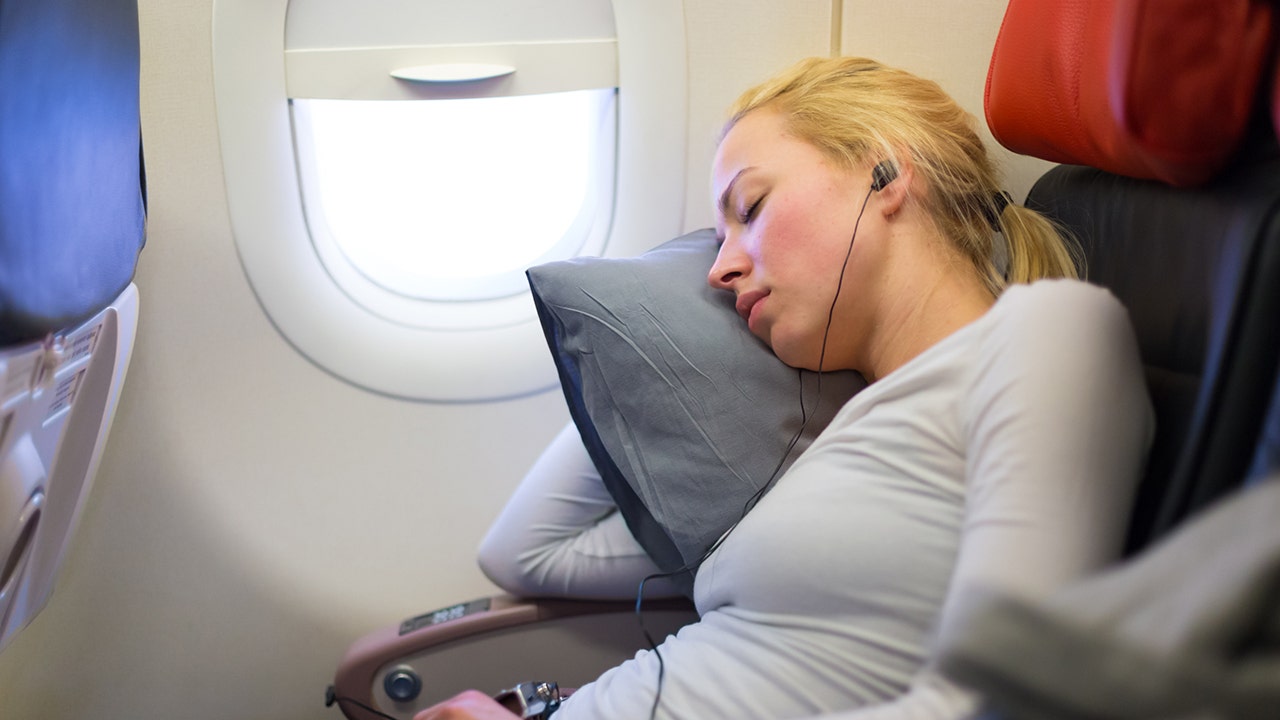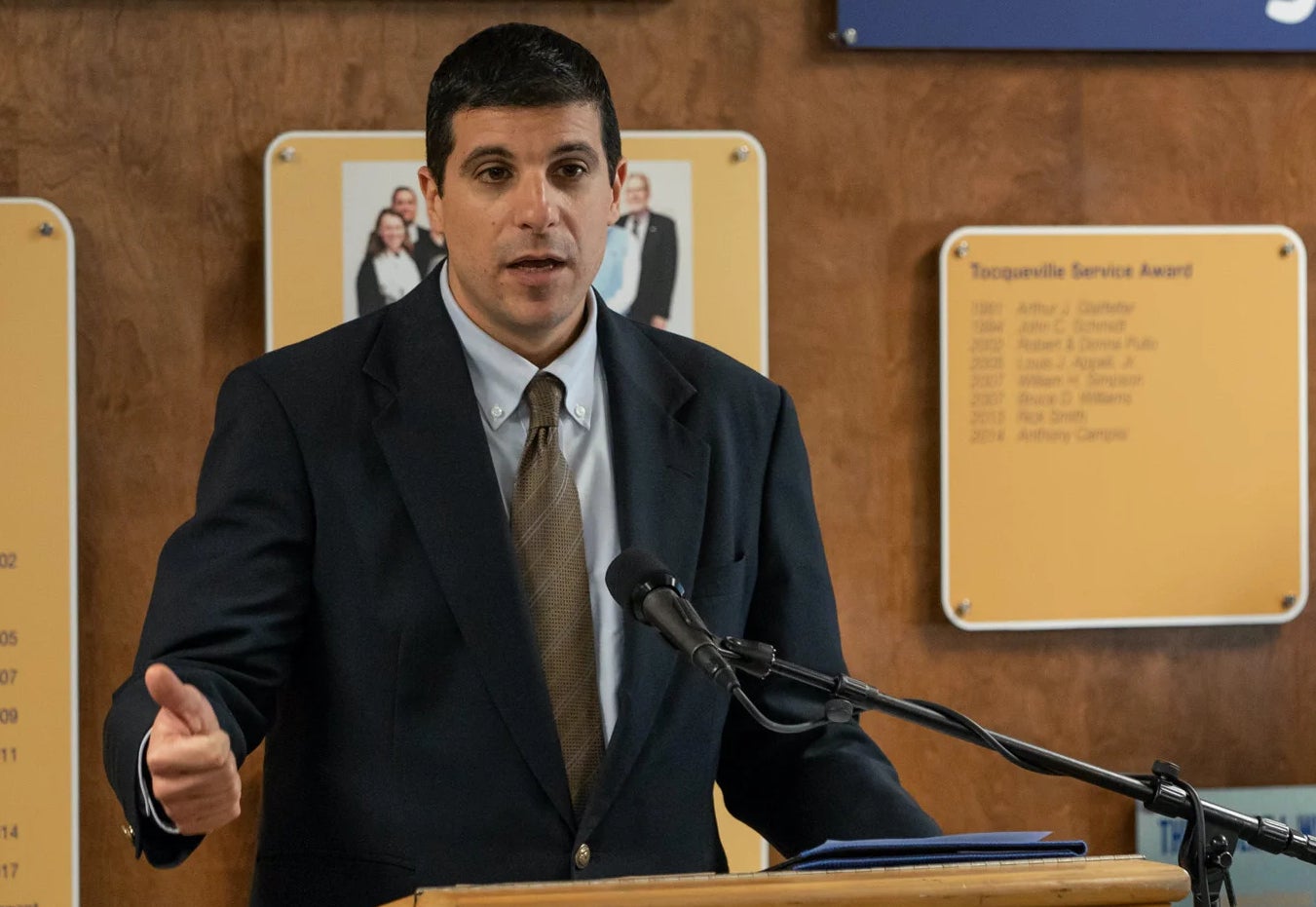Health
7 tips for falling asleep on long-haul flights (Hint: Skip the alcohol, coffee and sedatives)

For anyone who has taken a long flight — say, of six hours or longer — the goal is usually to sleep for at least part of the stretch, especially if it’s an overnight flight.
But falling asleep on a plane is not always easy, whether it’s a long flight or considerably shorter.
Fox News Digital spoke to sleep experts to ferret out their tricks and strategies about how to get some decent shut-eye on flights — so that you pass the time and arrive at your destination as refreshed as possible.
LACK OF SLEEP IS COMPROMISING THE MENTAL HEALTH OF 78% OF ADULTS, SURVEY FINDS
While sleep during travel can be challenging as the conditions and environment are very different than at home, take these thoughtful tips to heart.
1. Pick a seat that’s conducive to rest
Although the aisle seat gives you more freedom to stretch your legs and get up without a fuss, choosing a window seat in coach with a seat back that reclines and is far from the lavatory and galley is a better choice.
While an aisle seat may give you more freedom to stretch your legs and get up without a fuss, choosing a window seat in coach with a seat back that reclines and is far from the lavatory and galley is a better choice, say sleep experts. (iStock)
That’s according to Whitney Roban, PhD, a New York-based clinical psychologist, sleep expert and founder of Solve Our Sleep.
Or, splurge for business class, if you can, for an all-around better sleep experience, she suggested.
2. Wear the right clothes for travel
“Before you board, wash your face and change into loose-fitting clothing with comfortable socks,” suggested Roban — almost as if you’re getting ready for bed.
SLEEP EASY: 6 WAYS TO ADJUST YOUR BEDROOM SO YOU GET A GOOD NIGHT’S REST
It’s also a good idea to pack some extra layers in case the temperature on the plane changes.
3. Try to recreate other sleep strategies that work for you
“To help make your travel experience as smooth as possible, try to keep as much of your home sleep habits as you can,” said Peter Polos, M.D., PhD, a sleep medicine specialist and sleep expert for Sleep Number. He’s also an associate professor of sleep medicine at Hackensack JFK University Medical Center in New Jersey.

A child is shown sleeping with her toy puppy on a plane. “I recommend bringing a pillow from home, like an adjustable pillow that can support your head and neck, a smaller travel pillow that is easy to pack or even a sleep mask, which can help to block light,” said one health professional. (iStock)
“These [habits] include limiting cell phone or computer use within an hour of going to sleep,” Polos said.
4. Avoid certain foods and drinks
It’s best to avoid fatty foods and alcohol before or while on a long-haul flight.
Said Polos, “There are some general recommendations with respect to food and sleep, whether or not one is traveling. We recommend that foods high in fat, spice or acid content (such as tomatoes and some fruits) be avoided at or near bedtime.”
WWII-ERA MILITARY SLEEP METHOD COULD HELP INSOMNIACS NOD OFF QUICKLY, SOME CLAIM: ‘PEACE AND CALM’
He added, “There are many reasons for this, but one of the main ones is that fatty foods can put you at more risk for acid reflux, fluctuations in breathing patterns, delayed absorption and abdominal discomfort.”
Polos said as well, “Of course, caffeine should be avoided due to its stimulatory effect; however, caffeine can also be associated with dehydration. [And] alcohol is always contraindicated at bedtime.”

When traveling on a long flight and wanting to get some sleep, health experts recommend avoiding caffeine “due to its stimulatory effect” — it “can also be associated with dehydration,” which is another reason to avoid it. (iStock)
He shared more insight on that point: “Alcohol might help you fall asleep, but it can have a negative impact on your sleep cycle and cause you to wake up more and contribute to dehydration,” he continued. “It really should be avoided during travel.”
He also noted that stimulants like caffeine and alcohol can work in conjunction with the dry airplane cabin, resulting in significant dehydration. “This, too, can disrupt sleep.”
Although it’s reasonable to travel with snacks, Dr. Polos suggested selecting healthy, filling meals or snacks.
5. Bring your own travel sleep accessories
Airplanes aren’t always the most comfortable when you’re sitting upright, so Dr. Polos said it can become even more uncomfortable when you’re sitting in the same position for an extended period of time.
HEALTH TIPS FOR 2023: SLEEP ESSENTIAL FOR RESTORING YOUR BODY AND MIND
“I recommend bringing a pillow from home, like an adjustable pillow that can support your head and neck, a smaller travel pillow that is easy to pack or even a sleep mask, which can help to block light,” he said.
He also suggested listening to music or bringing some reading material.

“I recommend bringing a pillow from home, like an adjustable pillow that can support your head and neck, a smaller travel pillow that is easy to pack or even a sleep mask, which can help to block light,” said one sleep medicine specialist. (iStock)
“These may help reinforce [the] drive to sleep,” he suggested.
In addition, try to keep air vents open to make the air around you as cool as possible, said Polos.
6. Be careful about taking sedatives
Although you may be tempted to take something to induce sleep, it may not be the best idea. That’s according to Henry Ting, M.D., Delta’s chief health officer, based in Atlanta, Georgia.
“Be careful of taking any sedatives,” Dr. Ting said.
“Make your goal to be comfortable and relaxed, without any stress.”
“While taking sedative medication may be tempting, especially on a long-haul international flight, these medications affect neurotransmitters and can actually cause you to be more stimulated than relaxed,” he said.
CLICK HERE TO SIGN UP FOR OUR HEALTH NEWSLETTER
“Instead of sedatives,” he said, “opt for a good neck pillow and comfy clothes.”
7. Don’t get too stressed about falling asleep or not
It’s best not to stress if you can’t fall into a deep sleep on board the flight, Roban advised.
“Trying to force sleep will only make it more difficult to sleep,” she said.
“Make your goal to be comfortable and relaxed, without any stress,” she added.
“If you can succeed in staying relaxed in mind and body, sleep will come.”
For more Health articles, visit www.foxnews.com/health.

Health
Elderberry Boosts Weight Loss and Improves Blood Sugar, New Study Shows

Sign Up
Create a free account to access exclusive content, play games, solve puzzles, test your pop-culture knowledge and receive special offers.
Already have an account? Login
Use left and right arrow keys to navigate between menu items.
Use escape to exit the menu.
Health
Chicago's Lincoln Park Zoo loses flamingo, seal to bird flu

The Avian Influenza has claimed the lives of a Harbor Seal and a Chilean Flamingo at Chicago’s Lincoln Park Zoo.
The zoo announced they received results that confirmed the highly pathogenic Avian Influenza was the cause of Teal, a Chilean Flamingo, and Slater, a Harbor Seal’s death.
“This is sad news for wildlife and for the zoo team. Not only are we facing the first known cases of HPAI in animals in our care, but we’ve lost two amazing animals,” said Director of Veterinary Services Lester E. Fisher and Dr. Kathryn Gamble in a statement. “While highly pathogenic avian influenza is a naturally occurring virus in free-ranging waterfowl, more mammal species have been reported to be susceptible to HPAI since 2022.”
ONE STATE LEADS COUNTRY IN HUMAN BIRD FLU WITH NEARLY 40 CONFIRMED CASES
The zoo announced they received results that confirmed the highly pathogenic Avian Influenza was the cause of Teal, a Chilean Flamingo, and Slater, a Harbor Seal’s death. (Lincoln Park Zoo)
The zoo was unable to confirm the source of the exposure, but the Centers for Disease Control say that HPAI is spread through saliva, nasal secretion and the feces of infected birds.
They did say that zoo visitors are not at risk of contracting the disease from the animals at Lincoln Park zoo.
“Because highly pathogenic avian influenza is spread by free-ranging birds, it is no riskier to visit Lincoln Park Zoo than to enjoy a walk outdoors,” said President & CEO and ornithologist Megan Ross. “The zoo remains a safe place to connect with the animals in our care.”
BIRD FLU LEADS TO SEVERE HUMAN ILLNESS AND STATE OF EMERGENCY; EXPERTS DISCUSS RISK

The zoo announced they received results that confirmed the highly pathogenic Avian Influenza was the cause of Teal, a Chilean Flamingo and Slater, a Harbor Seal’s death. (Lincoln Park Zoo)
The zoo has been monitoring HPAI, so there is a response plan in place. The plan addresses staff and animals. It includes personal protective equipment and removing cross contamination between species while monitoring individual animal behavior, according to a statement by the zoo. They have also closed the McCormick Bird House and will be closed until further notice.

The zoo announced they received results that confirmed the highly pathogenic Avian Influenza was the cause of Teal, a Chilean Flamingo and Slater, a Harbor Seal’s death. (Lincoln Park Zoo)
The zoo also said in their statement that it’s important to keep personal pets indoors and away from wildlife.
“Sharing this news of highly pathogenic avian influenza in the area is important for our community at large,” said Director of the Urban Wildlife Institute Seth Magle. “To protect yourself, do not handle wildlife. Additionally, keep your pets safe by keeping cats indoors and dogs on a leash away from wildlife.”
Health
Insulin Prices Dropped. But Some Poor Patients Are Paying More.

Maricruz Salgado was bringing her diabetes under control. Thanks to a federal program that allowed health clinics that serve poor people to buy drugs at steeply discounted prices, she was able to pay less than $75 for all five of her diabetes medications every three months.
But in July, the cost of three of those drugs soared. Ms. Salgado, who does not have health insurance, suddenly faced costs of hundreds of dollars per month. She could not afford it.
Her doctor switched her to cheaper medicines. Within days of taking one of them, she experienced dizzy spells so severe that she said could barely keep up with her hectic daily schedule as a phlebotomist and an in-home caregiver. By the time she returned to the doctor in September, her blood sugar levels had ticked up.
“We were in a good place,” said Dr. Wesley Gibbert, who treats Ms. Salgado at Erie Family Health Centers, a network of clinics in Chicago that serves patients regardless of their ability to pay. “And then all the medicines had to change.”
The price hikes at the clinic happened for a reason that is symptomatic of the tangled web of federal policies that regulate drug pricing. In 2024, drug makers lowered the sticker price of dozens of common medications, which allowed them to avoid massive penalties imposed by the American Rescue Plan, the Covid relief package passed three years earlier. But that change backfired for low-income people like Ms. Salgado.
The decision to make these medications more affordable for large swaths of patients has quietly created another problem: a severe financial hit to the clinics that are tasked by the federal government with caring for the country’s poorest people. These nonprofit clinics operate in every state and serve nearly 32.5 million people, or about 10 percent of the country’s population.
“It’s the law of unintended consequences,” said Beth Powell, the director of pharmacy at The Centers, which operates five community health clinics in the Cleveland area. Ms. Powell said that while many consumers benefited from the companies’ decision to lower prices, “for our folks, that is not the case.”
More than 1,000 community health clinics around the country rely on a decades-old federal program that requires drug companies to offer them deep discounts.
Under the 340B program, as it is called, companies typically sell their brand-name drugs to clinics at a discount, at 23 percent or more off the list price. The same discount scheme applies to state Medicaid plans. But if a company raises a drug’s list price above the rate of inflation, a penalty kicks in, forcing it to offer even deeper discounts to the clinics.
For years, that meant that every time a company raised a drug’s list price above inflation, community clinics paid less for it. Many drugs, including insulin, essentially became free.
But the American Rescue Plan made a major change that hit drug companies with even larger penalties for raising prices. In January 2024, companies that continued to raise a drug’s price would have to pay state Medicaid plans every time those drugs were used, potentially costing the industry billions of dollars.
“That was a bridge too far” for the companies, said Antonio Ciaccia, a drug-pricing researcher who advises state governments and employers.
Manufacturers lowered the price of at least 77 drugs in 2023 and 2024, according to an analysis by a nonprofit that Mr. Ciaccia leads. The list includes widely used asthma drugs like Advair and Symbicort, as well as diabetes treatments like Victoza, which Ms. Salgado used before the change.
Once the pharmaceutical companies lowered their list prices, the inflation penalties evaporated. That meant community clinics had to start paying the usual discounts of 23 percent or more off the list price — far more than the pennies they used to pay.
“Unfortunately, the complexities of the U.S. health care system can reduce access and affordability for many,” Jamie Bennett, a spokeswoman for Novo Nordisk, which makes Victoza, said in a statement. “Even when we lower our prices, too often people don’t receive the savings — this is a problem.” She said the company also has patient assistance programs to make its products more affordable.
David Bowman, a spokesman for the Health Resources and Services Administration, which oversees the 340B discounts, did not respond to questions about how community health clinics were affected by the lowered drug prices. He said that other recent policies, including directing Medicare to negotiate the price of drugs, had lowered drug costs for low-income patients.
Because of a six-month lag in the way that 340B discounts work, clinics were hit by the change last July. Some clinics began calling patients before their prescriptions expired, offering to switch them to less expensive medicines even though they sometimes had more serious side effects. Others decided to cover the higher out-of-pocket costs, which required dipping into already scarce reserves.
Ms. Salgado said a nurse from Erie called over the summer to tell her about the pricing changes. Until then, she had paid about $15 for a three-month supply of Victoza, which is injected daily to keep blood sugar down. After July, the cost rose to more than $300.
After a few weeks, Ms. Salgado adjusted to the replacement, Byetta, and her dizziness subsided. But the drug must be injected twice a day instead of once. And Ms. Salgado must now use a special pharmacy 20 minutes from her house to qualify for the federal discount on the two insulin drugs she was switched to, the result of increasingly strict rules that companies are imposing on health clinics.
Ms. Salgado, who is 39, said she is determined to avoid the fate of her mother, who died of diabetes complications at 54. But keeping up with frequent pharmacy visits and medication changes is tough. “Sometimes it does get to a point where it’s like, I just don’t want to do this anymore,” she said.
The changes are also making it harder for community clinics to offer other services.
Under the 340B program, clinics buy the discounted drugs on behalf of their patients. When those patients have insurance, the clinics can then bill insurers for the regular, higher price, pocketing the difference. But now that spread — the difference between how much they pay for the drug and what insurance will cover — has dwindled. That has left clinics with less money to spend on services that are not otherwise covered by government grants or insurance, such as helping patients find housing.
At Valley View Health Center, a network of clinics that serves patients in rural Washington, the 340B money once financed a mental health program that employed eight therapists. In September, the clinic halted the program, laying off the therapists.
“It was such an abrupt change for us that it has definitely affected our ability to care for our patients the way that we needed to,” said Gaelon Spradley, the clinic’s chief executive.
Some patients who have seen costs go up have qualified for patient-assistance programs offered by drug makers. That was the case for Lorena Sarmiento, another patient at Erie Health who uses Lantus, an insulin pen. Last fall, after the 340B discount changed, she was quoted $490 at her pharmacy — the retail price for a box of insulin pens. Erie Health sent her to another pharmacy, which helped her sign up for a manufacturer’s coupon that lowered her cost to $35 per month.
Doctors and pharmacists at several health clinics said such drug-company assistance programs can be hit or miss. Sometimes they last for a limited time or require that a patient reapply regularly. Patients often have to be legal residents of the United States or have a fixed address.
“It’s a lengthy process, and it’s a lot of hoop-jumping,” said Michael Lin, the chief of pharmacy operations at Family Health Centers in Louisville, Kentucky.
Ms. Sarmiento and her husband, Luis, spend about $500 per month on her medical needs, including special food, medications and a glucose monitor. They are no longer facing the highest insulin price, but their costs are still 10 times what they were just a few months ago, when they spent about $10 on three months’ worth of insulin.
Mr. Sarmiento said he tries not to complain. “You always have to look on the good side,” he said. “But lately, that’s been hard.”
-
/cdn.vox-cdn.com/uploads/chorus_asset/file/25822586/STK169_ZUCKERBERG_MAGA_STKS491_CVIRGINIA_A.jpg)
/cdn.vox-cdn.com/uploads/chorus_asset/file/25822586/STK169_ZUCKERBERG_MAGA_STKS491_CVIRGINIA_A.jpg) Technology1 week ago
Technology1 week agoMeta is highlighting a splintering global approach to online speech
-

 Science5 days ago
Science5 days agoMetro will offer free rides in L.A. through Sunday due to fires
-
/cdn.vox-cdn.com/uploads/chorus_asset/file/25821992/videoframe_720397.png)
/cdn.vox-cdn.com/uploads/chorus_asset/file/25821992/videoframe_720397.png) Technology1 week ago
Technology1 week agoLas Vegas police release ChatGPT logs from the suspect in the Cybertruck explosion
-

 News1 week ago
News1 week agoPhotos: Pacific Palisades Wildfire Engulfs Homes in an L.A. Neighborhood
-

 Education1 week ago
Education1 week agoFour Fraternity Members Charged After a Pledge Is Set on Fire
-

 Business1 week ago
Business1 week agoMeta Drops Rules Protecting LGBTQ Community as Part of Content Moderation Overhaul
-

 Politics1 week ago
Politics1 week agoTrump trolls Canada again, shares map with country as part of US: 'Oh Canada!'
-
/cdn.vox-cdn.com/uploads/chorus_asset/file/23935558/acastro_STK103__01.jpg)
/cdn.vox-cdn.com/uploads/chorus_asset/file/23935558/acastro_STK103__01.jpg) Technology5 days ago
Technology5 days agoAmazon Prime will shut down its clothing try-on program















